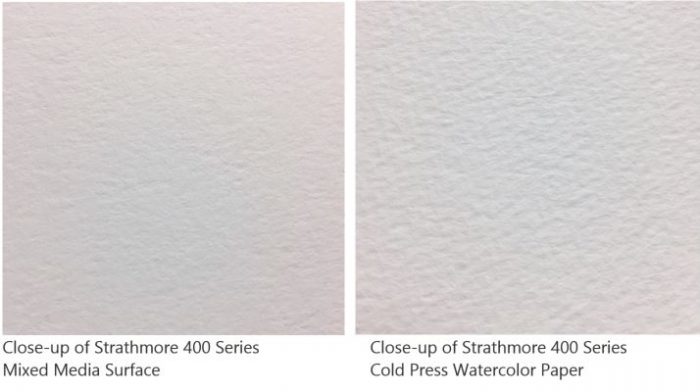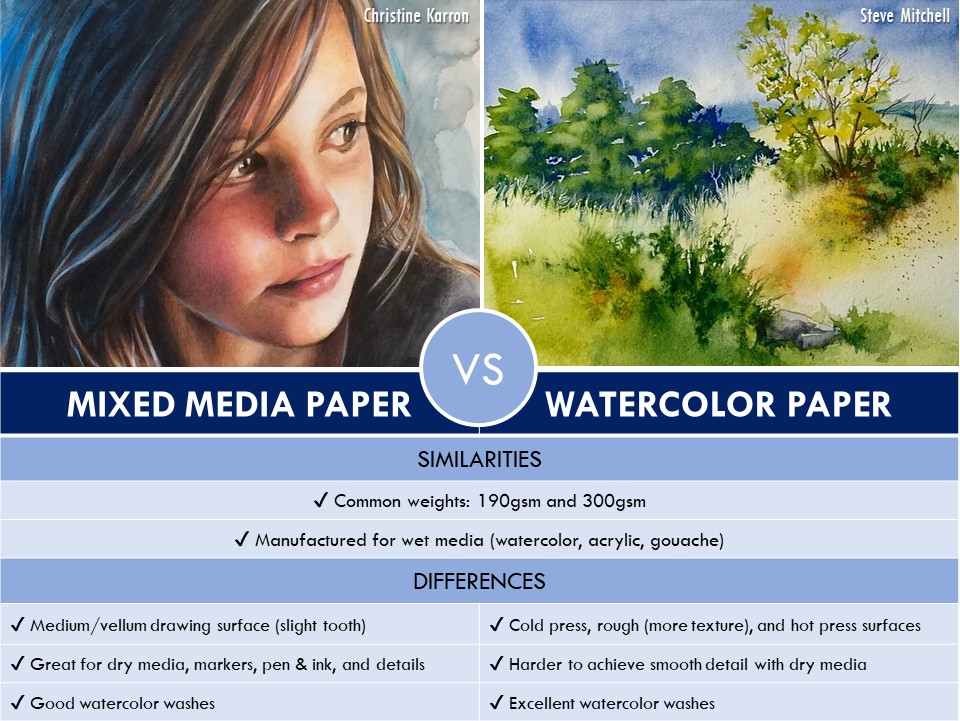Mixed Media vs. Watercolour Paper
July 23, 2021What is the difference between Mixed Media and Watercolour paper?
While there are many similarities between Mixed Media and Watercolour paper, the biggest difference is the surface. Mixed Media papers typically have a vellum/medium drawing surface with some tooth, while Watercolour papers traditionally have a more textured surface, making them ideal for different applications.
SIMILARITIES
✔ Weight:
Mixed Media and Watercolour paper both come in similar common weights: a lighter 190gsm and a heavier 300gsm. The lighter weight is better for sketching and practice applications. The heavier weight is best for finished work and heavier washes of watercolour. You may find both surfaces in some heavier and lighter weights, but these are the two most common.
✔ Wet Media Properties:
Both papers are sized to handle wet media applications. Sizing in the papermaking process refers to additives that make the sheets less porous. Without sizing, paper would react to moisture like a blotter or a paper towel. Type and amount of sizing applied to different papers varies based on the desired working properties. Mixed Media and Watercolour papers can use the same type of sizing; however, there will be some variation in the amounts used for both internal and external sizing based upon the weight and surface finish of the paper. The desired working properties for wet media sheets are uniform washes, clean lifts, no buckling, and enhanced surface strength to prevent pilling.
DIFFERENCES
✔ Surface:
Mixed Media papers typically have a medium/vellum drawing surface with a slight amount of tooth, allowing an artist to create better depth of tone with dry media like graphite. Mediums like marker, pen & ink, and colored pencil also work better on a mixed media sheet because the surface is much smoother than a traditional watercolour paper, allowing for finer and smoother detail.
The most common watercolour surface is cold press. Cold Press watercolour paper has a good amount of texture. Picture ‘peaks and valleys’. The added gaps (or more loosely compressed fibers) allow the watercolour to penetrate deeper into the paper and make an even tone easier to achieve. Mixed Media surfaces have smaller and fewer gaps (more compressed fibers). A helpful analogy would be to think of cold press watercolour paper as a bath towel, and mixed media paper as a polyester shirt. The bath towel will absorb water more easily than the polyester shirt.

Watercolour papers are also available in rough (more extreme peaks and valleys), and hot press (smoother).
A hot press watercolour paper is similar to mixed media paper in look; however, they are not exactly the same. A hot press watercolour is made with the same watercolour felt as a cold press watercolour in the papermaking process. The watercolour felt is what imparts the texture onto the sheet. The difference between hot and cold press watercolour comes at the end of the papermaking process when the paper passes through large rollers called ‘calender rolls’. The calender rolls are tightly compressed and add pressure to a hot press sheet, causing it to have a smoother surface. For cold press surfaces, the sheet passes through the calender rolls with less pressure, allowing the surface texture to remain intact. With a Mixed media paper, a drawing felt is used to press the vellum surface onto the sheet instead of a watercolour felt. This felt has a tighter weave, resulting in a smoother finish.

With a smoother surface, it can be somewhat more difficult to achieve as even of a tone with watercolour since the colors don’t have the peaks and valleys to settle into. However, some artists prefer a looser, less predictable look and with practice, many artists have found the mixed media surface to be ideal for their style.
✔ Dry Media Properties:
In recent years as more artists began experimenting with adding various mediums to their watercolour pieces, the need became apparent for a sheet that could handle both wet and dry media at the same time. Mixed Media papers are ideal for artists who like to work in watercolour and add detail with ink, colored pencil, marker, or other mediums on top (or vice-versa: starting with the detail and adding watercolour). While the cold and rough press texture of watercolour papers allow for even washes, it is more difficult to achieve details with the peaks and valleys. Think of a Mixed Media a hybrid between a drawing and a watercolour paper (surface of a drawing sheet + sizing of a watercolour sheet).
Refer to this chart for an overview of the similarities and difference between mixed media and watercolour papers.

Thank you to our friends at Strathmore for this article.

